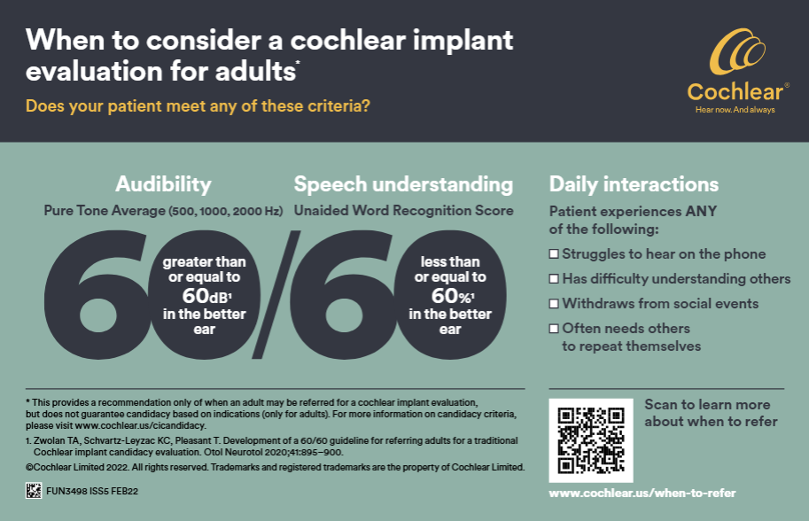Question
How do you ensure your patients follow through with your cochlear referral?
Answer
When hearing healthcare providers bring up a cochlear implant with a patient, it’s not uncommon to encounter hesitations or objections, so making the recommendation alone usually isn’t enough to ensure a patient will act.
Knowing the right time to refer a patient for a cochlear implant is crucial. The 60/60 referral guidelines were developed by Dr. Terry Zwolan and her colleagues at the University of Michigan and provided valuable data on optimal timing for a cochlear implant evaluation referral. It’s important for patients to understand the next step -an implant evaluation. At the evaluation their hearing will be tested both with and without hearing aids. The evaluation is just to help your patient understand more about their hearing loss, how they are performing with their hearing aids, and what options are available to them—the decision of what they want to do is always up to the patient. Referring for the evaluation will help them understand their hearing loss condition with more testing and will make them a better-informed patient.

It’s not uncommon for patients to have immediate hesitations or questions. Navigating this conversation can be challenging as a provider but what you say and how you say it matters.
Helpful tips to have the conversation with your patients:
- “Everything has been done to maximize your hearing with hearing aids - a cochlear implant may be the next best step to improved hearing”
- Focus on the next step for further testing to understand their options-they can decide from there what’s best for them.
- If someone is hesitant to proceed, ask them “Why?” - discuss their concerns
- In your discussion, focus on what they are likely to GAIN
Quick Tip: Dr. Terry Zwolan’s wrote a comprehensive guide on ‘How to Counsel Hearing Aid Users about their Prospective Candidacy for a Cochlear Implant’. It addresses common concerns, provides evidence-based counseling techniques, and emphasizes the importance of personalized care.
Take the Next Step:
Click the link below and with your patient’s consent, enter their information to connect them with a knowledgeable concierge who will personally guide them through the evaluation process.
We appreciate your dedication to exceptional care and better hearing for your patients.
Make a Referral – Make a Difference
To learn more about cochlear implant candidacy criteria, key strategies for building and maintaining strong referral relationships, and to learn how to develop a personalized action plan to enhance your referral processes and collaboration with local providers watch “Building Bridges: Developing Referrals Between Surgeons and Local Providers to Support Cochlear Implant Patients”
Disclaimers:
©Cochlear Limited 2025. All rights reserved. ACE, Advance Off-Stylet, AOS, Ardium, AutoNRT, Autosensitivity, Baha, Baha SoftWear, BCDrive, Beam, Bring Back the Beat, Button, Carina, Cochlear, 科利耳, コクレア, 코클리어, Cochlear SoftWear, Contour, コントゥア, Contour Advance, Custom Sound, DermaLock, Freedom, Hear now. And always, Hugfit, Human Design, Hybrid, Invisible Hearing, Kanso, LowPro, MET, MP3000, myCochlear, mySmartSound, NRT, Nucleus, Osia, Outcome Focused Fitting, Off-Stylet, Piezo Power, Profile, Slimline, SmartSound, Softip, SoundArc, True Wireless, the elliptical logo, Vistafix, Whisper, WindShield and Xidium are either trademarks or registered trademarks of the Cochlear group of companies. The names of actual companies and products mentioned herein may be the trademarks of their respective owners.
This material is intended for health professionals. If you are a consumer, please seek advice from your health professional about treatments for hearing loss. Outcomes may vary, and your health professional will advise you about the factors which could affect your outcome. Always read the instructions for use. Not all products are available in all countries. Please contact your local Cochlear representative for product information.

